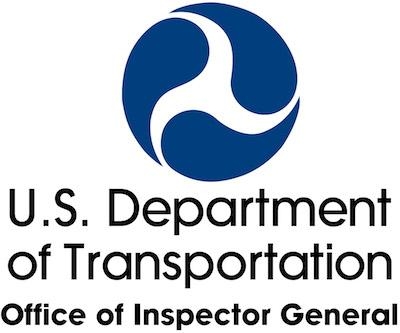Thu, Jan 04, 2018
Says Agency Should Enhance The Oversight And Management Of The Program
The Federal Aviation Reauthorization Act of 1996 gave the FAA authority to charge overflight fees to most aircraft operators that fly in U.S.-controlled airspace but do not depart or land in the United States. However, several airlines and air transport associations have sued the agency, stating that it lacked a reliable methodology for determining overflight fees, and the courts frequently overturned FAA’s practices.

The DOT Inspector General looked into the program and found that while the 2001 Aviation and Transportation Security Act states that overflight fees must be reasonably related to FAA’s costs for providing overflight services, and the Agency’s determination of those costs is not subject to judicial review. The OIG said it has previously found issues with FAA’s process for collecting the fees. Accordingly, an audit was initiated to assess FAA’s policies and procedures for ensuring that (1) overflight fees are accurately computed, (2) exceptions are appropriately applied, and (3) fees are collected or referred to the Department of the Treasury (Treasury) for collection in accordance with Federal laws and regulations.
The audit concluded that the FAA invoices aircraft operators for millions of dollars in overflight fees, but it does not have sufficient policies and procedures to ensure those fees are computed accurately. Moreover, FAA provides little oversight to the contractor who determines which flights are charged overflight fees and only minimal support to the personnel who generate the invoices.
The FAA’s policies and procedures also do not explain when to apply exceptions to the Federal requirement to send invoices only when monthly overflight fees are equal to or exceed $250. As a result, some users have been billed incorrectly. Finally, the FAA does not ensure that its overflight-fee debt-collection efforts comply with Federal laws and regulations. Based on our statistical sample, we project that invoices totaling $7.98 million (91.6 percent of the $8.71 million in the universe) have issues with timely referrals to the Treasury.
The OIG made six recommendations to help FAA strengthen its internal controls and ensure the accuracy, appropriateness, and collection of overflight fees. The include:
- Develop and implement policies and procedures to retain the original data files for purposes of validating the accuracy of the data being used to compute overflight fees.
- Develop a timeline that indicates when FAA overflight-fee officials will start using updated software (that meet its system reliability requirements) for computing fees.
- Develop and implement internal controls to oversee overflight-fee contractors, specifically, to review and approve flight data before the contractor submits them for billing.
- Develop and implement internal controls to oversee Enterprise Services Center employees and require debt-collection training to ensure overflight fees are properly billed.
- Establish policies and procedures that require staff to appropriately apply Federal laws and regulations and exclude aircraft users that are exempt or meet exception rules from receiving invoices for overflight fees.
- Develop and implement policies and procedures to ensure that overflight-fee collection activities comply with Department of the Treasury requirements, such as:a. Ensuring debtors are given due process; implementation of this recommendation could put $1.48 million in funds to better use.b. Assessing late charges on all delinquent debts; implementation of this recommendation could put $9.3 million in funds to better use.c. Making timely referrals of delinquent overflight fees to Treasury; implementation of this recommendation could put $7.98 million in funds to better use.
(Source: DOT OIG news release)
More News
Say Altitude Used by ATC to ascertain an aircraft's specific altitude/flight level. When the aircraft is climbing or descending, the pilot should state the indicated altitude round>[...]
Aero Linx: European Air Law Association (EALA) EALA was established in 1988 with the aim to promote the study of European air law and to provide an open forum for those with an int>[...]
From 2023 (YouTube Version): The Life, Death, Life, Death, and Life of a Glorious Warbird In 1981, business-owner Jim Tobul and his father purchased a Chance-Vought F4U Corsair. Mo>[...]
Also: USCG Retires MH-65 Dolphins, Irish Aviation Authority, NATCA Warns FAA, Diamond DA42 AD This summer, history enthusiasts will have a unique opportunity to experience World Wa>[...]
Also: WACO Kitchen Bails, French SportPlane Mfr to FL, Dynon-Advance Flight Systems, Innovation Preview Bobby Bailey, a bit of a fixture in sport aviation circles for his work with>[...]
 ANN's Daily Aero-Term (05.01.24): Say Altitude
ANN's Daily Aero-Term (05.01.24): Say Altitude ANN's Daily Aero-Linx (05.01.24)
ANN's Daily Aero-Linx (05.01.24) Classic Aero-TV: Korean War Hero Twice Reborn
Classic Aero-TV: Korean War Hero Twice Reborn Airborne 04.29.24: EAA B-25 Rides, Textron 2024, G700 Deliveries
Airborne 04.29.24: EAA B-25 Rides, Textron 2024, G700 Deliveries Airborne Affordable Flyers 05.02.24: Bobby Bailey, SPRG Report Cards, Skydive!
Airborne Affordable Flyers 05.02.24: Bobby Bailey, SPRG Report Cards, Skydive!



